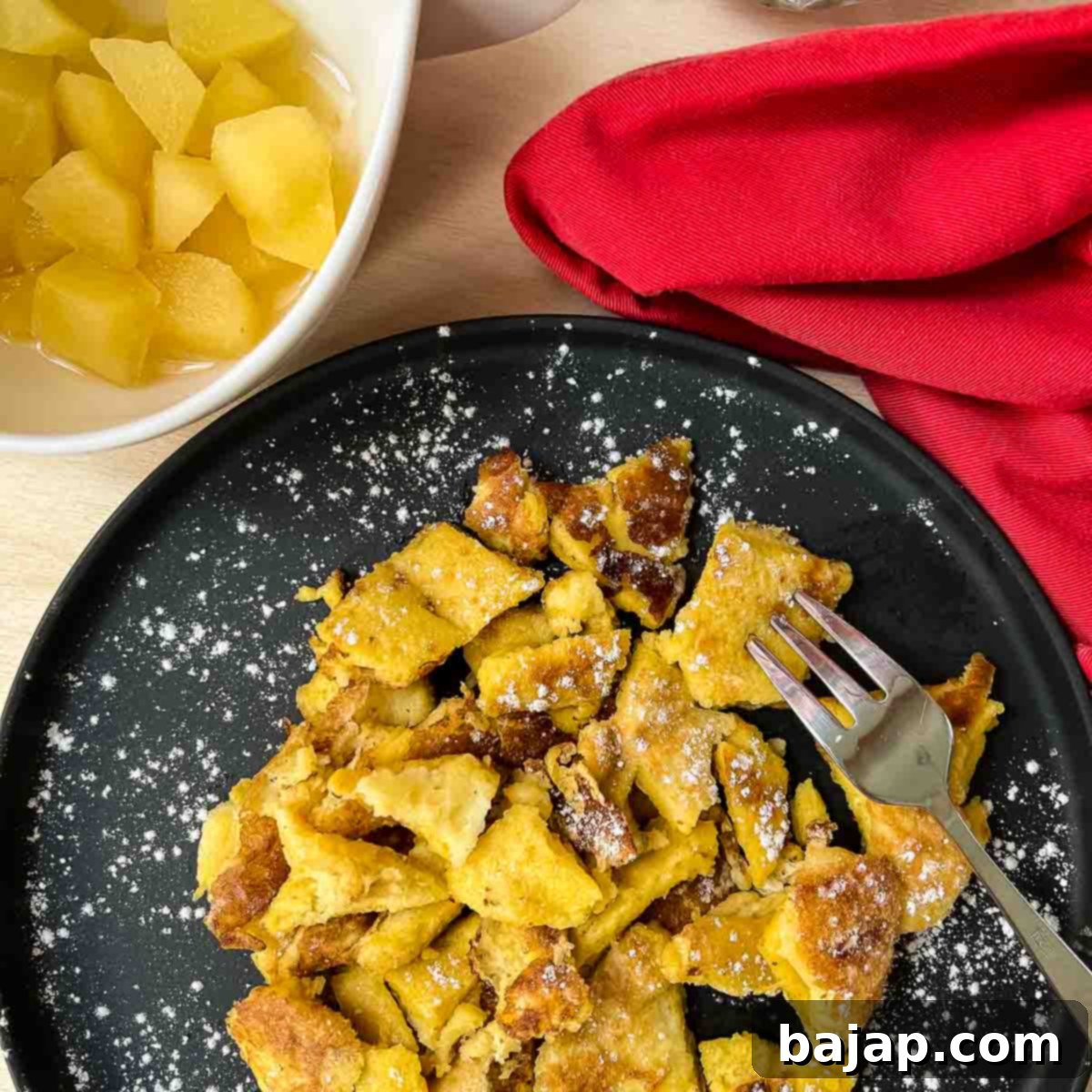Authentic Kaiserschmarrn Recipe: Fluffy Austrian Shredded Pancakes (No Raisins!)
Kaiserschmarrn, often referred to as Kaiserschmarren, is a beloved Austrian dessert that captures the essence of Alpine culinary tradition. Known charmingly by several names such as Emperor’s Mess, scrambled pancake, shredded pancake, torn pancake, or Emperor’s Pancake, this dish is far more than just a simple pancake. It’s a culinary legend, a fluffy cloud of sweet delight that has graced Austrian tables for centuries.
This particular easy Kaiserschmarrn recipe focuses on delivering that classic, melt-in-your-mouth experience without the addition of raisins, making it a perfect choice for those who prefer their pancakes pure and unadulterated. Prepared in under an hour, its incredibly fluffy, pancake-like texture and perfectly balanced sweet taste are guaranteed to win your heart and tantalize your taste buds. Imagine a light, airy, and gently caramelized shredded pancake dusted with powdered sugar, a true testament to simple yet sophisticated Austrian cooking.
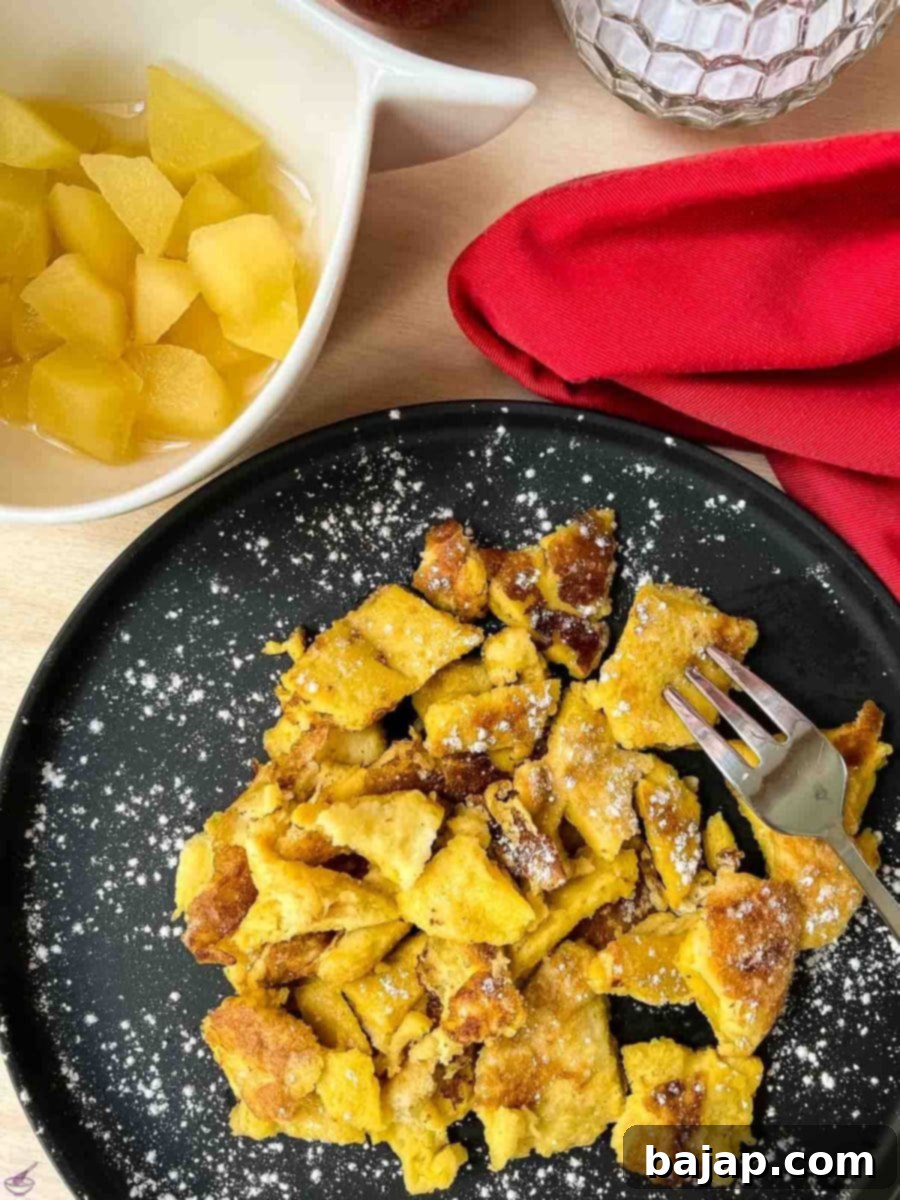
Traditionally, shredded pancakes can be prepared with or without raisins, soaked in rum or not, catering to individual preferences. The beauty of Kaiserschmarrn lies in its rustic preparation: the thick pancake batter is fried in a pan until golden, then artfully “torn” into bite-sized pieces with forks or spatulas. These pieces are then further cooked until caramelized and served generously dusted with powdered sugar, often accompanied by fruit compotes or roasted plums.
This traditional Austrian dish holds a special place in the hearts of many, famously enjoyed either as a satisfying sweet main course or a decadent dessert. Visitors to Austria, from the bustling streets of Vienna to the serene Alpine villages, will undoubtedly have encountered this delightful treat, experiencing its unique charm and unforgettable flavor at least once.
To truly embrace the authentic Austrian experience, serve your Kaiserschmarrn with classic accompaniments. The most popular choices include rich apricot compote, homemade apple compote, or traditional roasted plums (Zwetschgenröster). These fruity sides perfectly complement the sweetness and fluffiness of the pancakes, creating a harmonious symphony of flavors.
The Legend Behind Kaiserschmarrn: A Royal Indulgence
The origin of Kaiserschmarrn is steeped in charming anecdotes, most notably linked to Emperor Franz Joseph I of Austria, a monarch renowned for his simple tastes and love for traditional Austrian cuisine. The most popular legend suggests that the Emperor’s personal chef accidentally “scrambled” a pancake while trying to prepare a delicate dessert for him. Instead of discarding the imperfect creation, the chef tore it into pieces, dusted it with sugar, and served it with fruit. To everyone’s surprise, the Emperor adored this “mess” and it quickly became his favorite, thus earning the name “Kaiserschmarrn” – literally, “Emperor’s Mess” or “Emperor’s Scramble.”
Another tale tells of a peasant who served the Emperor a simple, thick pancake during a hunting trip. When the Emperor found it too coarse, his cook quickly tore it into pieces, sweetened it, and added fruit, transforming it into the royal delight we know today. Regardless of its exact origins, Kaiserschmarrn embodies a sense of comforting indulgence and has remained a staple in Austrian kitchens and restaurants, celebrated for its unique texture and versatile appeal as both a hearty meal and a sweet finish.
[feast_advanced_jump_to]
🥘 Ingredients for the Perfect Kaiserschmarrn
Creating magnificent Kaiserschmarrn relies on a few simple, high-quality ingredients that work together to produce its signature fluffy texture and rich flavor. Here’s a detailed look at what you’ll need:
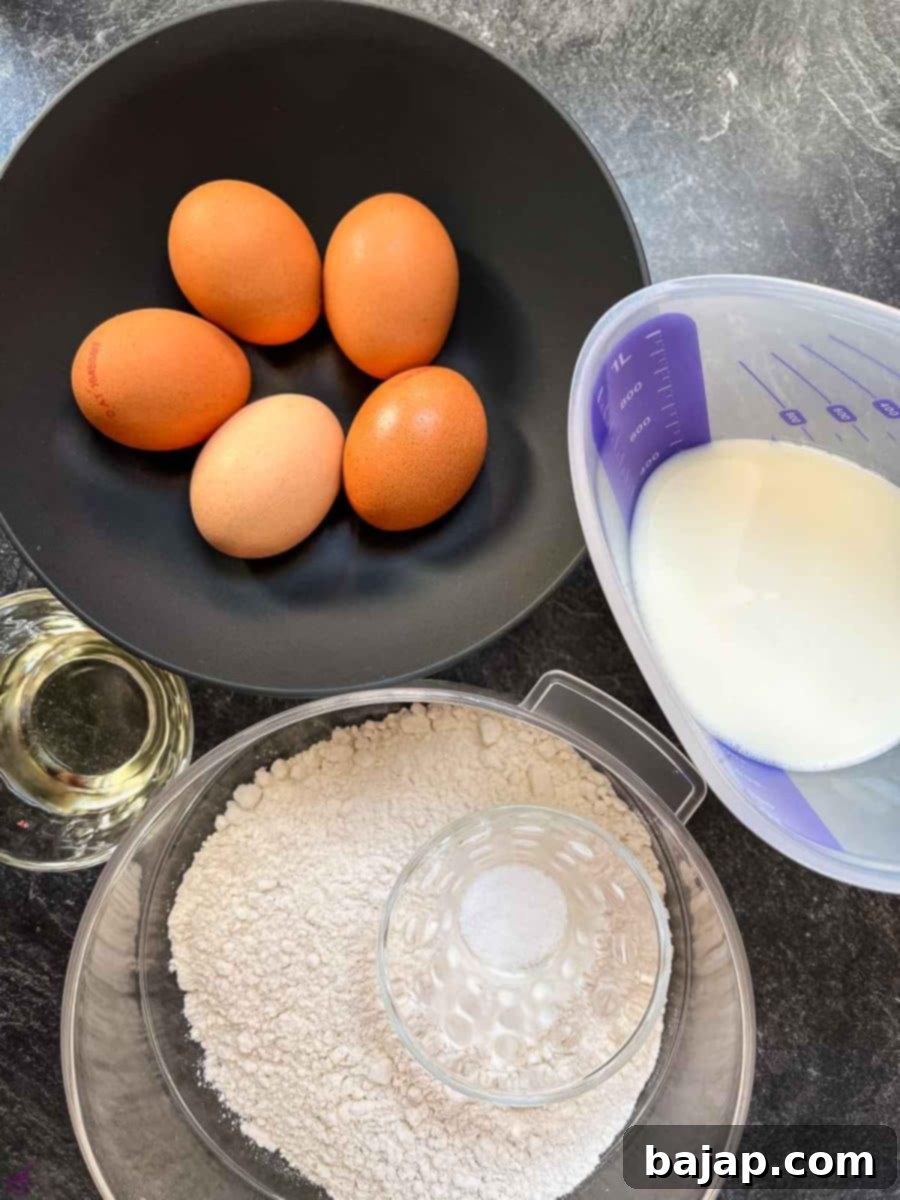
- Unsalted butter or oil: Butter adds richness and flavor, crucial for that golden crust. Oil is a neutral alternative.
- Eggs – medium-sized: The separation of yolks and whites is key to achieving the dish’s signature lightness. Yolks provide richness, while stiffly beaten whites fold in air.
- All-purpose flour: The base for the pancake batter, providing structure.
- Milk – whole milk: For a creamy, rich batter. It can be substituted with a plant-based alternative for dietary reasons, though the texture might vary slightly.
- Salt: A small pinch enhances all the sweet flavors.
- Granulated sugar: Sweetens the batter subtly.
- Powdered sugar – for sprinkling: Essential for the traditional finish, adding an elegant touch and extra sweetness.
- Optional: raisins and rum: For a classic variation, raisins (soaked in rum for added flavor) can be incorporated. This recipe, however, is designed to be delicious without them.
See the recipe card below for precise quantities.
🔪 Step-by-Step Instructions to Make Fluffy Kaiserschmarrn
Follow these detailed steps to create a truly irresistible batch of Austrian Kaiserschmarrn. Pay attention to the details for the best fluffy outcome!
Step 1: Preparing the Batter Base
Begin by carefully separating your eggs. Place the egg yolks into one large mixing bowl and the egg whites into another separate, clean, and dry mixing bowl. This separation is crucial for achieving the airy texture that Kaiserschmarrn is famous for.
To the bowl with the egg yolks, add the milk, a pinch of salt, and the granulated sugar. Whisk these ingredients together thoroughly until they are well combined and form a thick, smooth, and slightly pale yellow mixture. This ensures all the dry ingredients are fully dissolved and evenly distributed.
Next, gradually sprinkle in the all-purpose flour into the yolk mixture. Continuously stir as you add the flour to prevent lumps from forming. Mix until a cohesive, smooth dough mixture forms. The consistency should be somewhat thick. If you find the batter is too dense, you can carefully add a small amount of extra milk, a tablespoon at a time, until it reaches a thick but pourable consistency. Conversely, if it appears too thin, a tiny bit more flour can be stirred in.
Step 2: Incorporating the Egg Whites for Fluffiness
In the second bowl, where you have your egg whites, use a food processor or an electric mixer (with clean beaters!) to beat them until they form stiff peaks. This means when you lift the beaters, the egg whites stand firm and hold their shape. This step introduces a significant amount of air into the batter, which is essential for the light and fluffy texture of Kaiserschmarrn.
Gently fold the stiffly beaten egg whites into your prepared dough mixture. Use a spatula and a light hand, folding them in batches until just combined. Overmixing will deflate the egg whites and result in a less airy pancake. The goal is to retain as much air as possible.
Step 3: Pan-Frying and Shredding the Pancakes
Now, it’s time to cook your delicious pancakes! For the amount of batter this recipe yields, you will ideally need two large frying pans. Place a tablespoon of unsalted butter or a neutral oil (like canola or vegetable oil) into each pan and heat them over medium heat until the butter is melted and sizzling, or the oil is shimmering. Ensure the pans are hot enough, but not smoking.
Pour the batter evenly between the two heated pans, creating a thick layer in each. Let the batter spread naturally to form a round pancake. Fry the pancakes over medium heat. It’s crucial not to turn the heat up too high, as this will burn the outside before the inside is cooked through, leading to a bitter taste and an unappetizing texture. Patience is key here!
Once the bottom of the pancake is beautifully golden brown (this usually takes a few minutes, you can carefully lift an edge to check), it’s time to break it up. Using two spatulas, divide each large pancake into four roughly equal quarters. Carefully flip these quarters over in the pan to cook the other side.
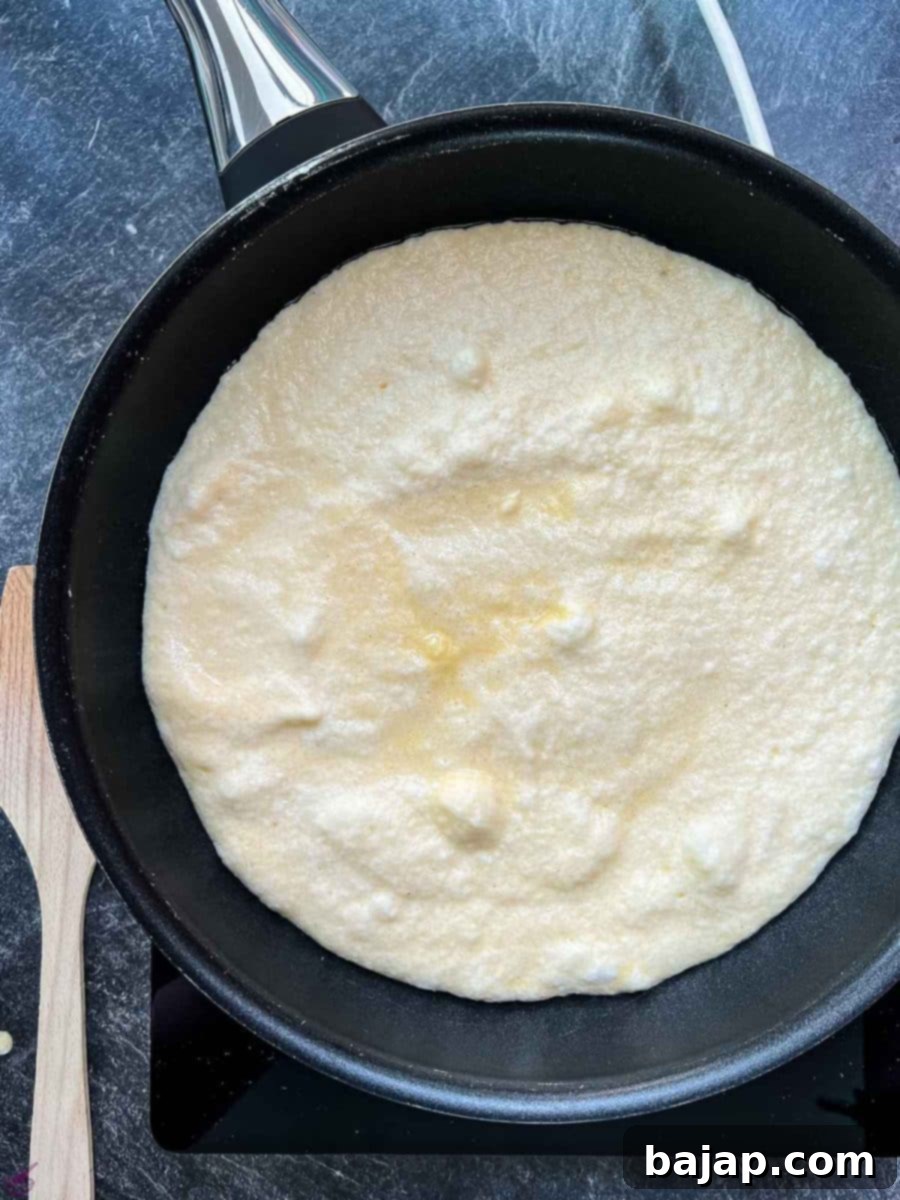
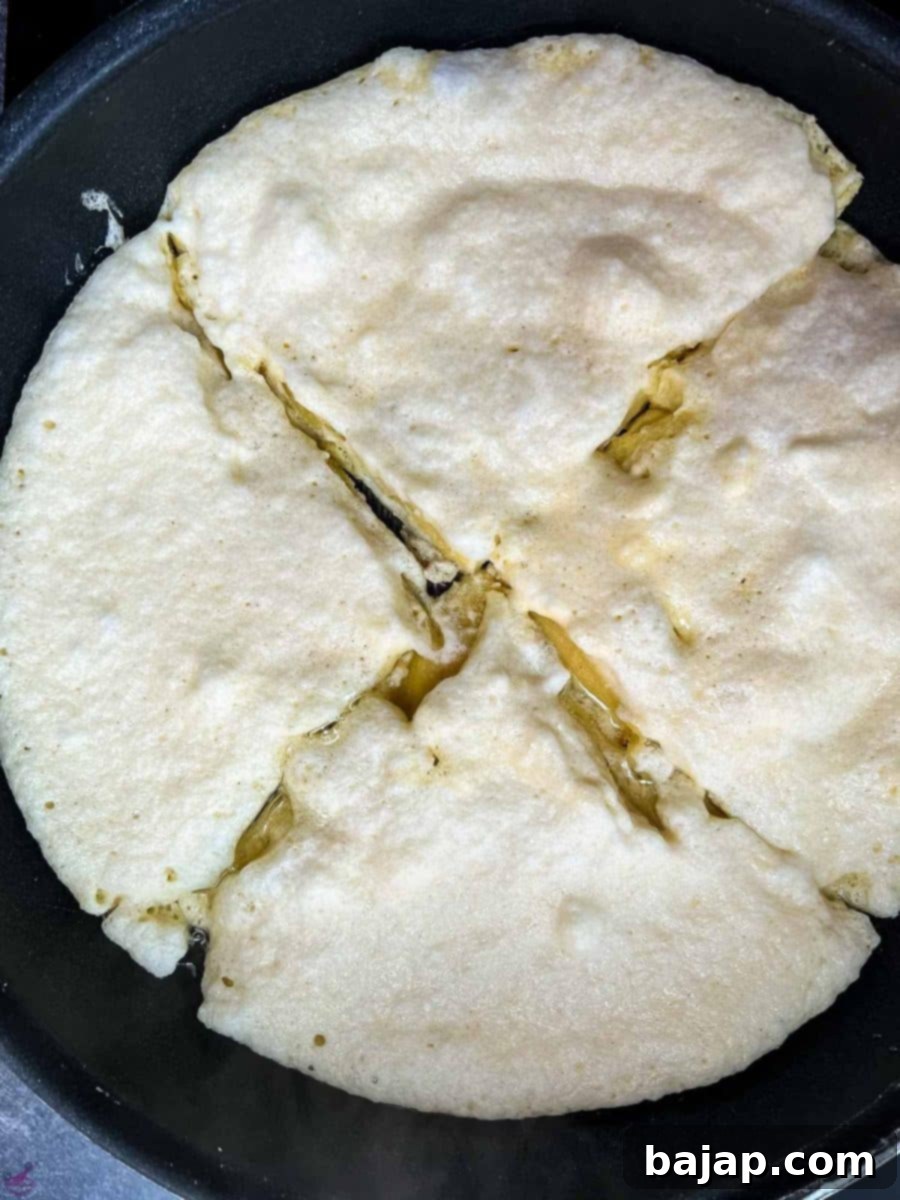
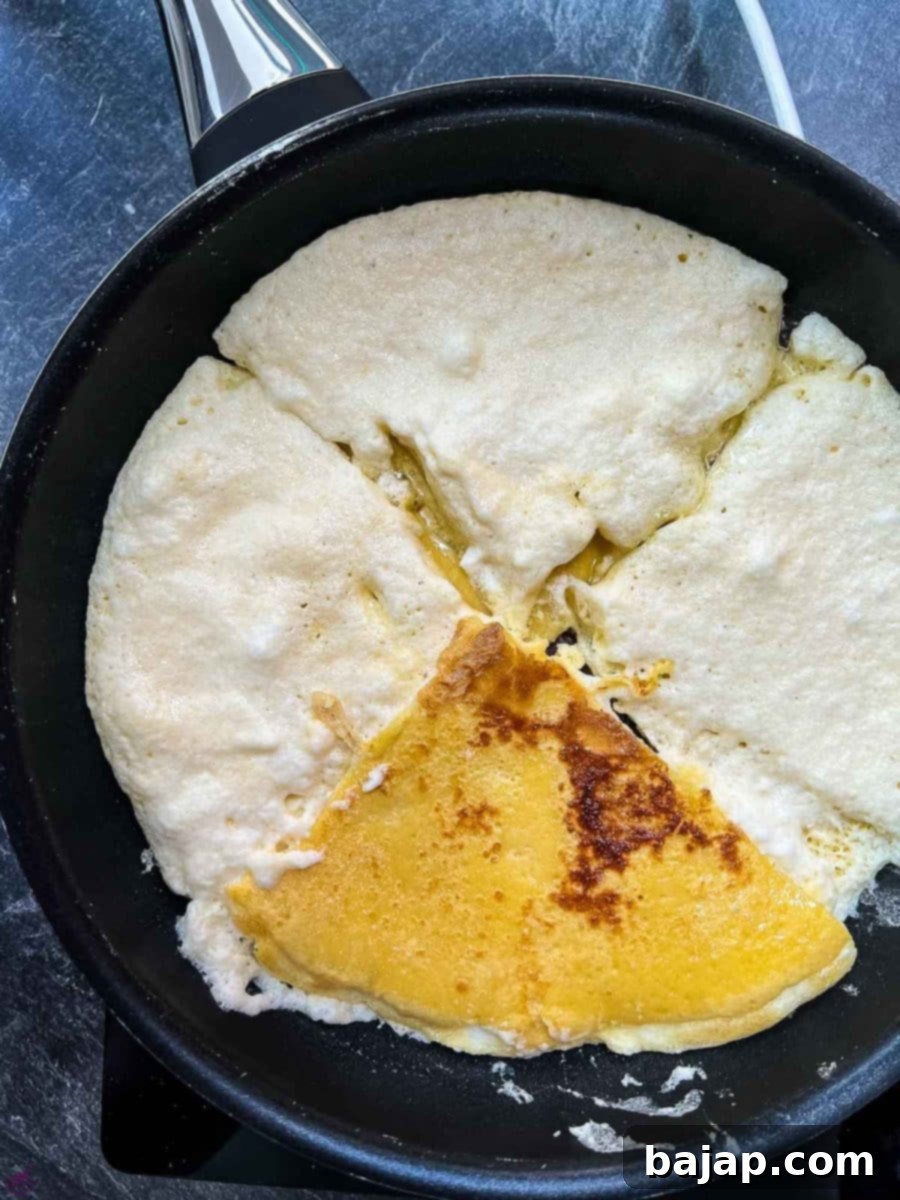
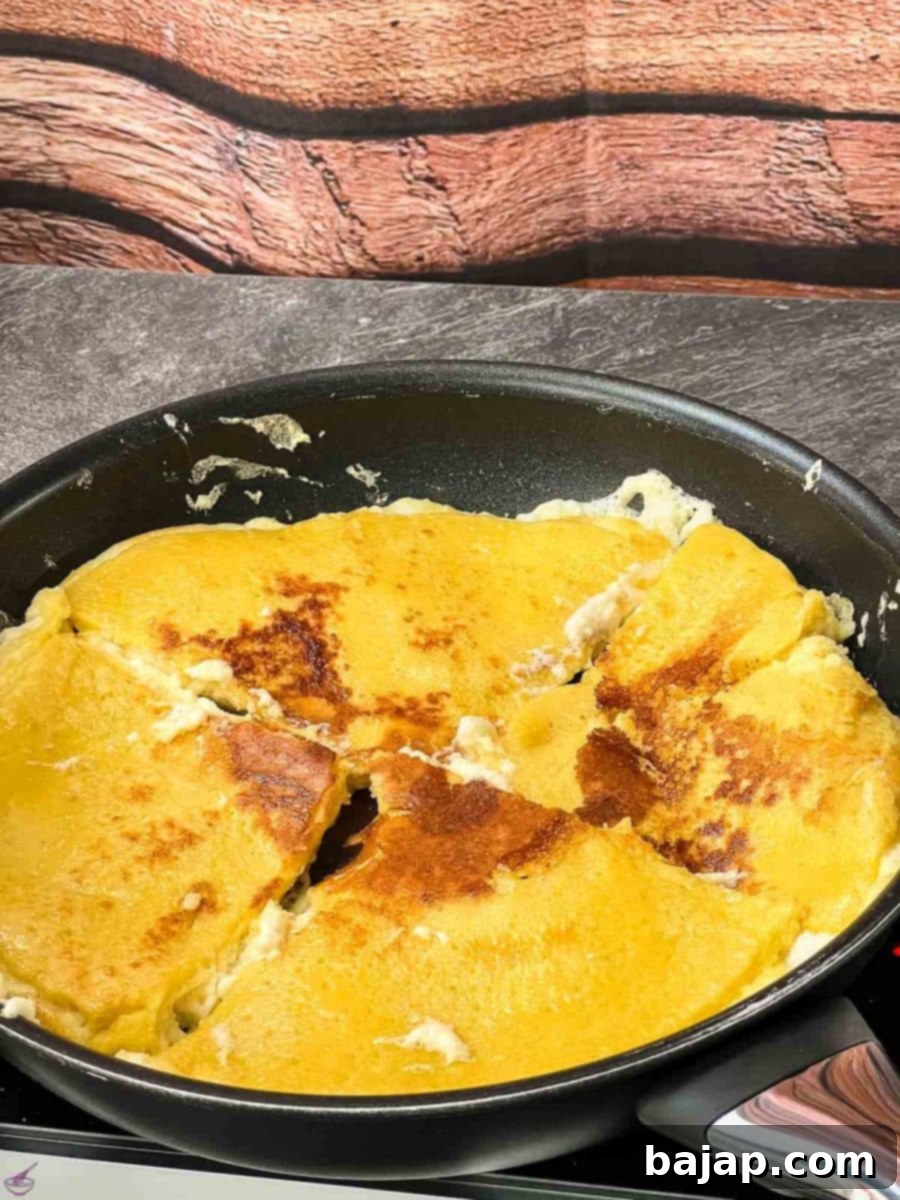
Continue frying the other side of these quarters until they are also golden brown. Once both sides are cooked, use your spatulas or forks to playfully pull and tear the pancake quarters into smaller, irregular, bite-sized pieces. This “shredded” or “torn” appearance is characteristic of Kaiserschmarrn, giving it its unique charm and texture.
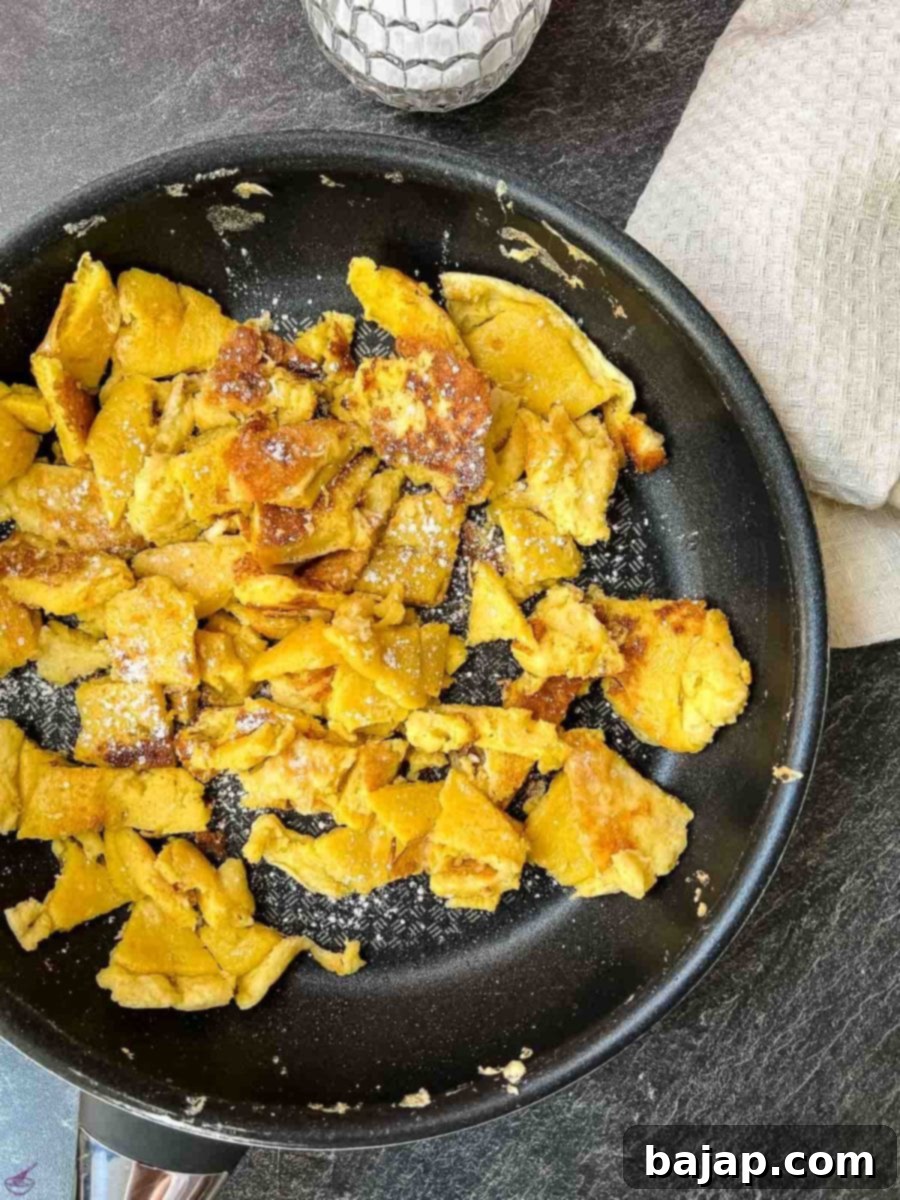
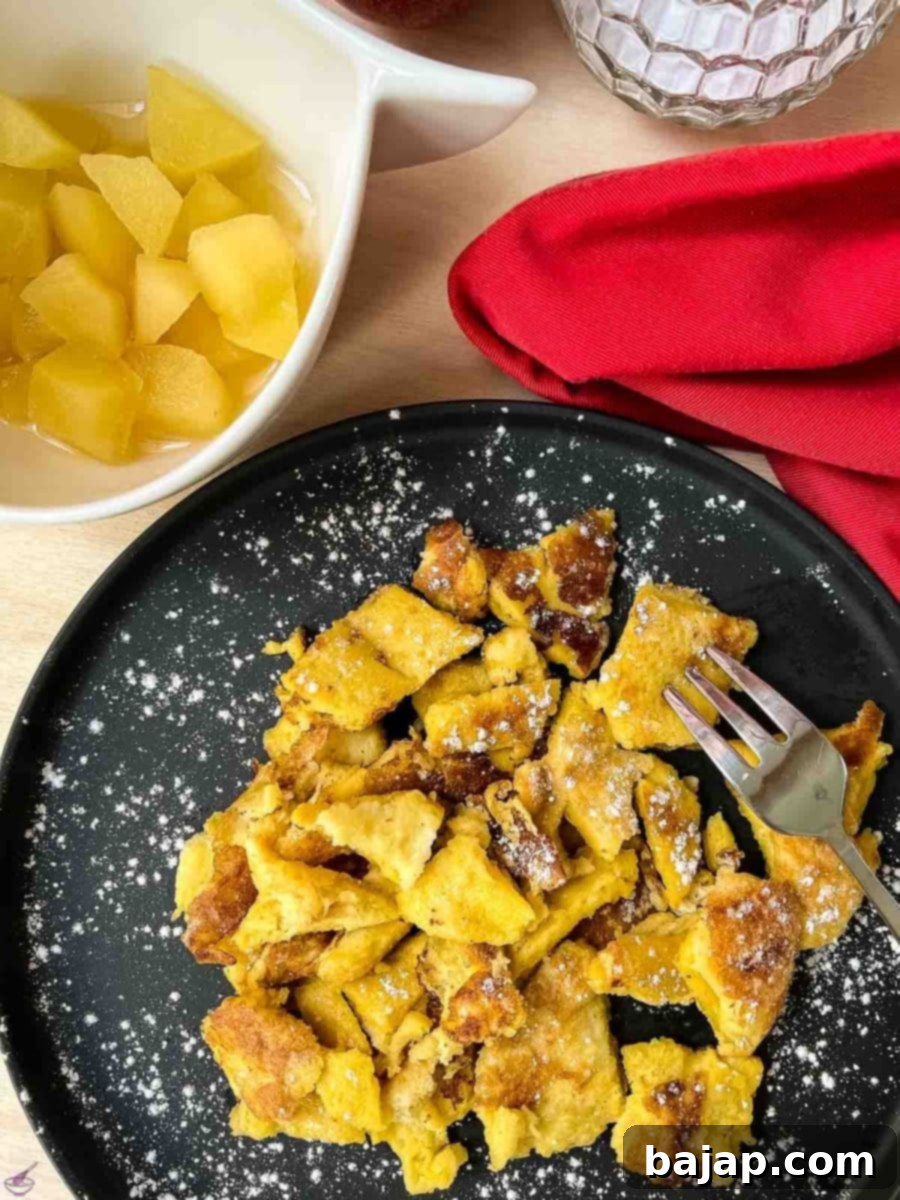
Step 4: Caramelization and Serving
Once you have torn the pancakes into pieces, stir them around in the pan a few more times. This ensures that all the surfaces of the scrambled pieces get a chance to brown evenly, adding depth of flavor and a slightly crisp edge.
For the final flourish, generously sprinkle some powdered sugar directly over the Kaiserschmarrn pieces in the pan. Continue to stir them gently over medium heat, allowing the sugar to melt and caramelize slightly onto the pancakes. This creates a beautiful glossy sheen and a delicate sweet crunch, elevating the taste experience.
Carefully divide the finished Schmarrn onto individual plates. For an authentic presentation and extra sweetness, dust them one last time with a fresh layer of powdered sugar. Serve immediately with your preferred accompaniment – whether it’s classic apple compote, traditional Zwetschgenröster (roasted plums), or a luscious apricot compote. Enjoy this delightful traditional Austrian meal!
🇦🇹 Fancy More Traditional Austrian Recipes?
If Kaiserschmarrn has sparked your interest in Austrian cuisine, there’s a world of delicious dishes waiting to be explored. Austrian cooking is known for its hearty, flavorful, and comforting meals, often combining influences from its historical empire. Here are a few more traditional Austrian recipes you might enjoy:
- Tafelspitz (Austrian prime boiled beef): A sophisticated yet simple boiled beef dish, often considered the national dish of Austria.
- Apfelkren (Austrian apple horseradish sauce): A zesty and refreshing condiment that perfectly complements meat dishes, especially Tafelspitz.
- Schnittlauchsauce (Chives Sauce): A creamy, herb-infused sauce that adds a fresh touch to many Austrian meals.
- Erdäpfelschmarrn (Austrian grated pan-fried potatoes): A savory potato dish, often served as a side or a light meal, similar in spirit to Kaiserschmarrn but with potatoes.
- Kandierte Veillchen mit Sekt (Candied violets with sparkling wine): A luxurious and elegant dessert or aperitif, famously enjoyed by Empress Elisabeth (“Sisi”).
- Liptauer (Liptauer cheese spread): A spicy and flavorful cheese spread, a popular snack or appetizer.
🍇 Variations: Customizing Your Kaiserschmarrn
While this recipe prides itself on being a raisin-free delight, Kaiserschmarrn is a versatile dish that welcomes variations. The most classic addition is, of course, rum-soaked raisins:
Variation with rum and raisins: If you enjoy the traditional flavor profile that raisins and rum bring, it’s simple to incorporate them. Add a shot of rum (about 1-2 tablespoons) and 50-100g (approximately ¼ – ¾ cup) of raisins to the batter right before Step 2. This means you should mix them into the egg yolk and flour mixture, just before you whip the egg whites and fold them into the batter. The raisins will plump up slightly and infuse the pancake with a delightful fruity, boozy aroma.
Other delicious variations:
- Nutty Kaiserschmarrn: Add chopped almonds or walnuts to the batter for a pleasant crunch and nutty flavor.
- Chocolate Chips: For a more modern, kid-friendly twist, sprinkle in some mini chocolate chips before frying.
- Different Fruits: Instead of raisins, try dried cranberries or chopped dried apricots for different fruity notes.
- Citrus Zest: A little lemon or orange zest in the batter can add a bright, refreshing aroma.
🍽 Essential Equipment
Making Kaiserschmarrn doesn’t require specialized tools, but having the right equipment makes the process smoother and ensures the best results:
- Two frying pans – ideally with a non-stick coating: Using two pans allows you to cook the batter efficiently and ensures each portion cooks evenly without overcrowding. Non-stick is highly recommended to prevent sticking.
- Food processor or electric mixer: Absolutely essential for beating the egg whites until stiff peaks form, which is critical for the Kaiserschmarrn’s airy texture.
- Two large mixing bowls: One for the egg yolk mixture and one for beating the egg whites separately.
- Two spatulas: Ideal for flipping the pancake quarters and, more importantly, for tearing the cooked pancake into characteristic shredded pieces without damaging the pan.
🌡 Storage Tips for Leftover Kaiserschmarrn
While Kaiserschmarrn is best enjoyed fresh off the pan, sometimes you might have leftovers, or you might want to prepare it ahead of time. Here’s how to store it effectively:
Kaiserschmarrn can be stored in the refrigerator for one to two days. Make sure to pack it in an airtight container to prevent it from drying out and absorbing other food odors. When reheating, gently warm it in a pan over low heat or in a microwave until heated through. Be careful not to overcook, as it can become tough.
You can also freeze shredded pancakes for longer storage. After frying, allow the Kaiserschmarrn to cool completely (do not sprinkle with powdered sugar before freezing, as it will get soggy). Transfer the cooled pieces into a Ziplock bag or an airtight freezer-safe container. Press out as much air as possible before sealing and freezing. This way, your delicious Kaiserschmarrn will keep for several months. While freezing might cause it to lose a tiny bit of its initial fluffiness upon reheating, it will still be incredibly tasty and satisfying. To reheat from frozen, spread the pieces on a baking sheet and warm in a preheated oven at 350°F (175°C) for about 10-15 minutes, or until heated through and slightly crisp.
💭 Top Tip: Keeping Everyone Happy!
If you’re dealing with a household where some love raisins and others don’t, here’s a simple solution to please everyone: prepare the Kaiserschmarrn batter without raisins, as specified in this recipe. After the pancakes are cooked and shredded, and just before serving, simply sprinkle raisins over the portions of those who enjoy them. This way, my husband doesn’t have to pick out the dreaded dried grapes, and my daughter is thrilled to get her beloved raisins!
🙋🏻 Frequently Asked Questions About Kaiserschmarrn
Here are some common questions about Kaiserschmarrn, its history, and how to enjoy it:
The name Kaiserschmarren is a combination of the German words “Kaiser” (Emperor) and “Schmarren.” “Schmarren” is a colloquial expression in Austrian and Bavarian dialects, meaning a trifle, a mishmash, a mess, or even nonsense. It is related to the verbs “scharren” (to scrape) and “schmieren” (to smear). The name reflects the legendary story of Emperor Franz Joseph I and his liking for this “scrambled” or “messy” pancake, which was supposedly an accidental creation by his chef or a simple peasant dish elevated for royal taste.
Course: Wikipedia
Kaiserschmarrn unequivocally originates in Austria, making it a quintessential Austrian dish. However, due to cultural and historical ties, it is also very popular and commonly found in regions of Southern Germany, especially Bavaria, and the German-speaking part of Switzerland. While enjoyed across these areas, its roots and primary association are with Austrian cuisine.
Traditionally, Kaiserschmarrn is served with a variety of fruit accompaniments. The most popular choices include stewed plums (Zwetschgenröster), homemade applesauce, or various fruit compotes such as apple compote, plum compote, apricot compote, or strawberry compote. These sweet and sometimes tart fruit sides provide a perfect counterpoint to the rich, fluffy pancake.
The secret to Kaiserschmarrn’s exceptional fluffiness lies in the careful separation of eggs and the incorporation of stiffly beaten egg whites. The egg yolks, milk, and flour create a rich batter base, while the whipped egg whites are gently folded in to introduce air, making the pancake light and airy. Cooking it over medium heat allows it to puff up and cook through without becoming dense.
Yes, with some adjustments, you can adapt Kaiserschmarrn to be vegan or gluten-free. For a vegan version, use plant-based milk, substitute eggs with a flax egg or a commercial egg replacer, and use vegan butter or oil. For a gluten-free version, swap all-purpose flour for a good quality gluten-free all-purpose flour blend. Be aware that texture might vary slightly with these substitutions.
If you make this recipe, let me know how you liked it by ★★★★★ star rating it and leaving a comment below. This would be awesome! You can also sign up for our Newsletter or follow me on Pinterest or Instagram and share your creation with me. Just tag me @combinegoodflavors and hashtag #combinegoodflavors, so I don’t miss it.
📖 Recipe Card: Austrian Kaiserschmarrn – Torn Pancakes
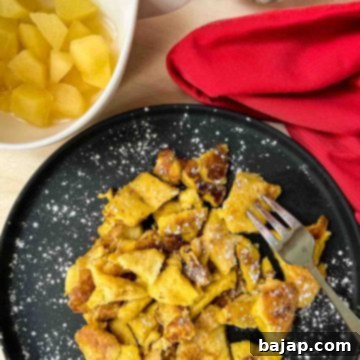
Austrian Kaiserschmarrn – torn pancakes
Nora
Save RecipeSaved!
Pin Recipe
Equipment
-
2 Pans
-
Food processor or electric mixer
-
2 Large mixing bowls
-
2 Spatulas
Ingredients
- 2 teaspoon Unsalted butter or oil
- 5 Eggs
- 1 ½ cups All purpose flour
- 1 ½ cups milk
- 1 Pinch Salt
- 1 teaspoon Sugar
- Powdered sugar for sprinkling
Optional
- Raisins ¼ – ¾ cup
Instructions
-
Carefully separate 5 Eggs into two large, clean mixing bowls (yolks in one, whites in the other).5 Eggs
-
To the egg yolks, add 1 ½ cups milk, 1 Pinch Salt, and 1 teaspoon Sugar. Mix well until combined.5 Eggs, 1 ½ cups milk, 1 Pinch Salt, 1 teaspoon Sugar
-
Gradually sprinkle in 1 ½ cups All purpose flour into the yolk mixture, stirring constantly until a smooth, thick batter forms. Adjust consistency with a little more milk or flour if needed.1 ½ cups All purpose flour
-
Beat the egg whites in their separate bowl until they form stiff peaks. Gently fold these stiff egg whites into the prepared batter, being careful not to deflate them.
-
Heat 2 teaspoon Unsalted butter (or oil) in two large frying pans over medium heat until hot.2 teaspoon Unsalted butter
-
Pour the batter evenly into both pans and cook over medium heat until the bottom is golden brown.
-
Divide each pancake into quarters in the pan and flip them over to cook the other side until golden brown.
-
Using spatulas or forks, tear the cooked pancakes into small, bite-sized pieces.
-
Stir the shredded pancakes a few more times to ensure all pieces are golden brown and cooked through.
-
Sprinkle Powdered sugar over the Kaiserschmarrn in the pan and let it caramelize slightly while stirring. Optionally, add Raisins at this stage for those who like them.Powdered sugar, Raisins
-
Divide the finished Kaiserschmarrn onto plates, dust with extra powdered sugar, and serve warm with your favorite fruit compote.
Nutrition values are estimates only, using online calculators. Please verify using your own data.

🇦🇹 More Austrian Delights You Might Also Like
If you’ve enjoyed making and savoring this Kaiserschmarrn, you’re likely to appreciate other traditional Austrian recipes. The rich culinary heritage of Austria offers a wide array of comforting and flavorful dishes, perfect for any occasion. Here are some more recommendations:
- How to make an Apple Compote
- Vanilla Bean Ice Cream Pancakes {Palatschinken}
- Best way to make Iced Coffee
- Delicious Elderflower Fritters {Air Fryer}
⛑️ Food Safety Guidelines for Home Cooking
Ensuring food safety is paramount when cooking to prevent foodborne illnesses. Please keep these important guidelines in mind while preparing your Kaiserschmarrn or any other meal:
- Minimum Cooking Temperature: Always cook eggs and any other ingredients to a minimum internal temperature of 165 °F (74 °C) to eliminate harmful bacteria. While Kaiserschmarrn is a sweet dish, ensuring the eggs are thoroughly cooked is essential.
- Prevent Cross-Contamination: If you are preparing other dishes that involve raw meat, never use the same utensils or cutting boards on cooked food that previously touched raw meat without thorough cleaning and sanitization.
- Handwashing: Wash your hands thoroughly with soap and warm water for at least 20 seconds after touching raw ingredients, especially eggs, and before handling cooked food.
- Temperature Control: Do not leave perishable food sitting out at room temperature for extended periods (generally no more than two hours). Promptly refrigerate leftovers to inhibit bacterial growth.
- Supervision: Never leave cooking food unattended, especially when frying. Accidents can happen quickly.
- Cooking Oils: Use cooking oils with a high smoke point to avoid the breakdown of oils into harmful compounds and to prevent unpleasant smoke in your kitchen. Butter can brown quickly, so monitor heat.
- Ventilation: Always ensure good ventilation in your kitchen when using a gas stove or frying, to remove cooking fumes and prevent the buildup of indoor air pollutants.
For further comprehensive information and best practices on food safety, always refer to reputable sources such as the Safe Food Handling – FDA guidelines.
